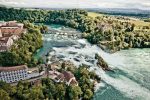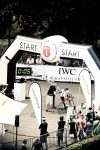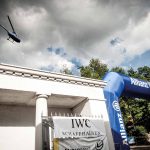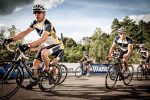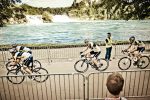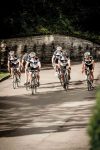IWC Schaffhausen
At The ‘Sufferfest’ — Tortour 2012
IWC Schaffhausen
At The ‘Sufferfest’ — Tortour 2012
These were the thoughts in my head, as disbelief, denial, frustration, anguish and then rage flashed through my brain in a millisecond. I had dropped my chain, straight through the gap between my chainring and the bottom bracket. I was pedaling air, the chain — no longer a mechanism for forward propulsion — hanging limp and devoid of life. Saying a prayer, I pressed the electronic button to shift the chain back up to the outer chainring — a desperate move that succeeds only one out of 10 times.
And this time, the result was to send the chain up and over the outer chainring to become tangled in my crankset. Everything jammed. My back wheel began to lift as I started over the handlebars and hit the ground. That’s what it feels like to fall off your bike: one minute you’re upright, the next you’re not.
As I rolled to the ground, I saw my five teammates in the 2012 Tortour Laureus 2 Team — six-time Ironman champion Ronnie Schildknecht, European Duathalon champion Andy Sutz, 2012 Olympic mountain-bike silver-medalist Nino Schurter, champion mountain biker Marcel Bartholet, and my friend and CEO of race sponsor IWC, the incomparable Georges Kern — pound up the 20-percent incline, out of their saddles, bikes rocking from side to side, legs straining to overcome gravity fueled by their rage, their pride, their conviction as they shot straight up the incline to the finish line of the prologue.
The first leg is an amazing 60km team time trial where you fly through Schaffhausen and the surrounding area at speeds between 40kmh and 50kmh, with a follow car blazing its lights to light the night streets. Then come three solo stages, each between 50km and 90km, usually with a high degree of elevation, which means climbing in the Alps.
Then you have a short ceremonial arrival ceremony at the IWC Arena in Schaffhausen. In total, you do about 250km each, but because of the nonstop nature of the race, and because you are totally amped on energy gels and Red Bull, you never really sleep. The prologue is the beginning of Tortour and the streets on either side of the climb are lined with screaming spectators, with a helicopter filming the event hovering over the Rhine. Unfortunately, the attention was all focused on me as I tried to leap back on my bicycle on the steep incline. Alas, I was unable to clip in my pedal and fell again.
In truth, it was a rookie error, one that you’re told under no circumstances to do: pedaling hard when you are shifting. Why? Because bad shit happens when you do. In my case, approaching the 180° turn, I shifted too late. I was already well into the turn, and with my heart and brain going into adrenaline overdrive, I applied too much torque to the pedals while simultaneously shifting to the small chainring up front and the biggest cog out back. As I watched my five teammates celebrating at the finish of the incline, I was filled with shame. Noticing that I seemed distracted, Georges asked if I was all right. I replied, “I feel like punching myself in the face.”
Along the way, I came down with every ailment conceivable — heat exhaustion, skin rashes, fungal infections, massive bleeding abrasions on my inner thighs. I also sprained both of my rotator cuffs, necessitating Lidocaine injections directly into both my arm sockets, and had to have a massive cortisone injection directly into my crotch to remove a saddle sore days before the race.
In all those weeks, with an average mileage of 250km per week, the mantra taught to me by Vincent was, “Don’t fall and don’t get sick.” Yet one week before Tortour, I’d caught a violent lung infection which had me on two different kinds of antibiotics, and which, in turn, had given me a spell of diarrhea so violent that I felt jet-propelled; and even worse, in the first minute of the first stage of the race, I’d eaten asphalt. I had become cycling’s Job. The only thought that prevented me from directly riding off the side of the road and into the waiting jaws of the Rhine Falls was that things could only get better.
But the thing about Tortour was there was no time to rest. And if you were looking for the opportunity to redeem yourself, then you needed to only wait a few hours. Literally four hours later on the team time trial, I felt better. My lungs labored, but my legs felt strong.
As the course was undulating but largely flat, I felt well within my comfort zone. I put my head down and spun the pedals the way Vincent taught me, and just over an hour later, we arrived to a strong result. I headed into the camper van feeling better, but still looking for redemption. I had, at this point, no idea what was in store for me.
Cycling is a strange sport because a large percentage of what it entails is essentially pain management. Rather than trying to avoid pain, the vast majority of competitive cyclists seem to welcome it. In Tortour — the name of the race itself is a riff on the word “torture” — cyclists wear jerseys that say things such as, “Welcome to the sufferfest”.
If you’ve watched any race coverage of the Tour de France, you’ll notice that British commentators tend to delight in phrases like, “Now he’s really beginning to suffer; look at the suffering.” Lance Armstrong used to say that it was not that he was any better of a cyclist than the next guy, but it was just that he could suffer more than anyone else. While recent evidence points to the fact he was indeed physically superior due to chemical enhancement, his capacity for suffering was nonetheless absolutely, undeniably, superhuman.
In no one discipline in cycling do you suffer more than in climbing. There is something uniquely painful about cycling uphill because you must continue to generate enough momentum to keep your bike from toppling over — but that momentum comes at an agonizing cost to your legs and your lungs. On steep inclines, there is no other way to describe climbing than, essentially, a slow and very deliberate form of self-inflicted torture as your lungs claw for oxygen, your legs strain with agony, snot drips out of your nose, and rivers of sweat pour off you.
A further rule of thumb is, the heavier you are, the more you suffer, because of the additional weight your legs and lungs have to haul uphill. Imagine it this way: if you have the same leg strength and lung capacity as the next guy but weigh 5kg more than him, it’s like tying a 5kg sack of flour to your back as you charge up a hill.
So, I am a heavy guy who lives in a flat country where the highest hill we have is 163m in elevation.
As my first solo stage was explained to me, I began to have a full comprehension of the pain lying in wait for me on a 50km mountain stage in the Alps which featured a 15km climb to the top of a mountain that involved ascending 1,900m with an average gradient of about 11 percent, and which had long stretches in excess of a 15-percent incline.
Georges Kern cheerfully explained to me, “I climbed this as part of the training and I absolutely don’t want to do it in the race. It will be extremely painful for you.” When I rebutted, “Georges, you do realize I live in an almost totally flat country,” Kern grinned widely and replied, “You know, Wei, when I assigned you this stage of the race, I gave you a great gift. I gave you the gift of fantastic stories to tell at dinner parties for the rest of the year. Enjoy!”
What is it about the human body that makes suffering so painful when you undergo it, but so damn funny when you talk about it later?
This was what Kern was referring to as his “gift”, and it’s true; looking back now at my first solo stage of the race, the abject sorrowful suffering that I inflicted on myself is absolutely, uproariously funny.
What was it like in reality during the stage? It was probably the greatest physical pain I’d ever experienced…
With each turn of your cranks, a small explosion of pain courses through your body — the dull ache of your legs, the gasping of your lungs. The world sways and rocks as you throw your bike from side to side. Just as you think your legs are going to seize, you make a small adjustment to your position and some small relief floods through your body. You stand up on the pedals to relieve the pain in your perineum, but then, the quadriceps begin to cramp. You sit back down and your hamstrings and calves burn; your breath is ragged and you are constantly on edge, as your heart hammers away in your chest like a bird trying to liberate itself from a cage.
Then you look up and you see the mountain passes that stretch on for a heart breaking infinity. There is no end in sight, no relief in sight; for a moment, you think about riding directly off the mountain path and careening down the chasm as the soothing embrace of death takes you.
Then you look up and you see the mountain passes that stretch on for a heart breaking infinity. There is no end in sight, no relief in sight; for a moment, you think about riding directly off the mountain path and careening down the chasm as the soothing embrace of death takes you.
Amusingly, I had already vanquished the first climb — the agonizing near-2km-in-elevation mountain that nearly killed me. But no one told me that there was a second mountain, and that this one, though only half the height of the first, was just as much of a motherfucker as the first one. I recalled Andy Sutz chuckling to himself and referring to this part of the race as “not so easy”. That is the fucking understatement of my lifetime. But I was desperate to finish — I’d already lost the team over 40 minutes. I shouted to myself, “Keep climbing asshole, keep climbing.” The follow car was awesome — every kilometer or so, they pulled over and shouted encouragement; the other riders that passed me too shouted encouragement; and all the while, my mind was locked on a specific image that kept me going.
As another tremor of pain exploded through my body, I thought back on how I came to be on the side of this goddamn mountain. Flashback to eight months ago from that moment, at the 2012 Geneva Salon International de la Haute Horlogerie (SIHH). There was a dinner held by the SIHH’s CEOs the night before the fair. As a cycling fan, I was fascinated to learn that each year, IWC’s dynamic boss Georges Kern participates in a nonstop 1,000km cycling race for charity around Switzerland. When I asked him about it, he smiled and said, “Wei, you know I’m never intimidated by celebrities or really anything or any person. But this bicycle race… it scares the shit out of me. And that’s why I force myself to do it every year. Unless you participate in it, you will never be able to understand who you really are in moments of the most abject suffering. Wei, my proposal is not that you follow me when I do this race, but that you participate on my team.”
Over the next few months, at Kern’s urging, I looked inside myself and questioned if I had the guts, the testicular fortitude, for the sufferfest that is Tortour. Finally, one day, I decided that I had to do it. I remember the moment of solemn finality when I sent the email saying “yes” to the incredible Philippe Amarante who helped to organize the race. Amusingly, up until the moment I got off the plane, Kern and Amarante were still scratching their heads as to whether or not I would show up. “Maybe we should get an alternate,” Kern would say to Amarante, “just in case.”
My reverie was broken as I reached a 1km stretch at the end of the stage that looks like a ladder to heaven: it is that steep. Amazingly, Amarante pulled alongside of me in the sponsor’s Porsche to shout encouragement. On the side of the road, a guy was pushing his bike. As I pulled my foot up through the crank stroke, I actually ripped the tip of my cleat and my foot popped out of the pedal. For a moment, I thought I was going to fall again. But somehow, I managed to stay upright. I put my unclipped foot on the pedal and just pounded away until I got to the end, and miraculously, around the bend, the road flattened and I could see the finish point.
In the next hours, I would ride two more solo stages, providing me with unforgettable experiences like hurtling through mountain passes at 70kmh, with the light so dim you couldn’t tell if you were turning right or left; riding as the sun rises and the fog hangs low over the wet fields; passing magnificent plunging ravines; and yes, finally passing other riders (like I said, I’m better at the flat stuff). I would also make incredible friends with the group of riders and support staff, and finish the ride feeling better about myself than I had in a long time.
At the end of the race, Georges Kern gave me a beautiful ceramic Big Pilot Top Gun Miramar with the words “I survived Tortour 2012” engraved on the caseback. But the real gift he gave me was that goddamn mountain and an experience that has taught me a great damned deal about myself, which I will never forget. As an act of friendship and generosity, it was an incredible gesture and one that I am eternally grateful for. Merci, Georges. You’re the man!




